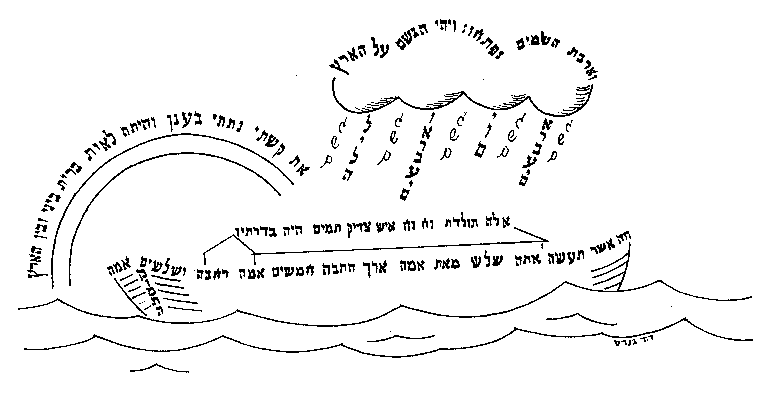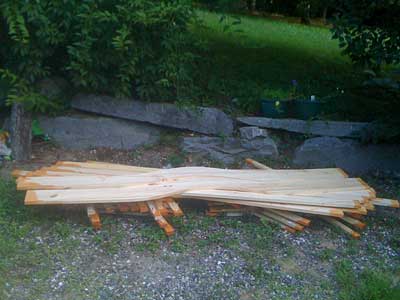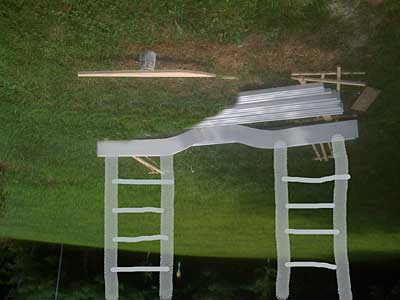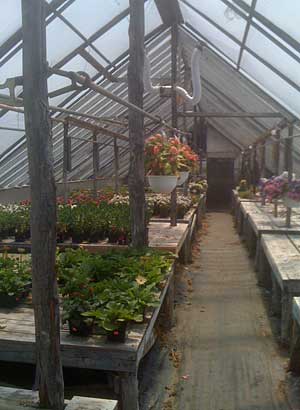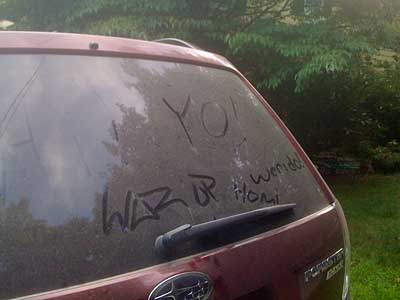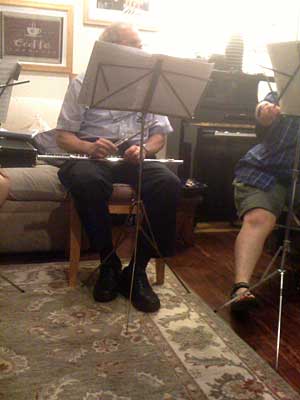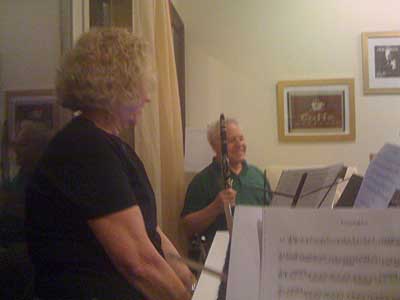Last weekend (July 24 and 25) we were, uncharacteristically, in two picture-postcard type New England churches.
Being Jewish, of course I don’t go to church as such. Synagogue now and then, but not church; but when I was in college, I went to chapel services at the college enough to become comfortable with Protestant services. At least my freshman year, and I think sophomore year also, chapel attendance, at least half the time, was required. This was before the big student protests of the late ’60s, so the college could get away with that; but it wasn’t popular. Thinking about it, I can remember a song which showed up in a stack of mimeographed copies in the student union one day in the spring of freshman year. I think the people who wrote it included some people active with the chapel, too, like Paul Valliere and Scudder Parker (I’m just saying, so that if they google themselves they might find this post and be surprised that anyone remembers. Although Scudder ran for governor of Vermont a few years ago and will find zillions of internet references to that). After a few days of thinking about it, I can remember this much. I think there were other verses:
At 10 o’clock each Sunday morn we hear the chapel bell
Calling us to worship there with it’s familiar knell
Seven each semester, or you all will go to hell
So let’s all go to chapel now!
refrain: Glory, glory, what an easy way to go
(ditto)
Glory, glory, well, it’s better than chapel pro [bation]
So let’s all go to chapel now!
Once upon a time there was a thing called ‘chapel pro’
But lots of us were on it, so the trustees all said, “No,”
“If you should miss a chapel, why then, out’s the place you’ll go.”
So let’s all go to chapel now!
[refrain]
Our chapel here at Williams is beset by many foes.
The chaplain is against it, although every week he goes.
But God is strongly for it, which th’administration knows,
So let’s all go to chapel now!
[refrain, with extra gusto!]
You didn’t have to go to the college chapel. If you went to some other church service in town, you could hand in a card with your name to an usher, who would deliver the cards to the college so you could be credited. We Jewish students ran our own services on Friday evenings (I led my share of those) and handed in our attendance cards for that; but I liked to go to the college chapel occasionally.
Back to the present!
First, on Saturday night, we went to another in the summer music series at the Windham Hill church:
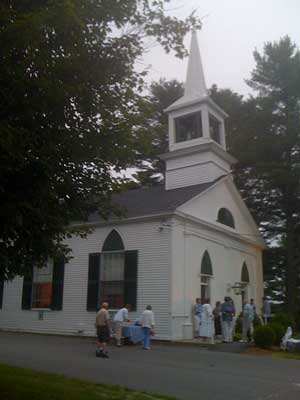
This one is a small building, as I probably said last week. I counted more carefully this time, and got 32 pews that each hold four people comfortably. It’s old enough that it doesn’t have running water; the restrooms are in the community hall, which is a separate building.
The concert was by the Denny Breu trio. Denny is one of the best guitarists we’ve run into, and not bad as a songwriter. We’ve heard him three times at the Tom Rowe memorial concerts in Lewiston and once before at Windham. His wife played various flutes — regular soprano C flute, alto, and a Native Americal flute that looked a little like mine but, unlike mine, plays in tune.
There was a monster traffic jam on Route 302 when we drove down. We had left in time, we thought, to get some frozen custard (that was supper) and stop at a hardware store for more paint for that arbor; but shortly after the frozen custard the traffic was backed up. I took the side road through Raymond Village, but the traffic was backed up on 121 getting onto 302. I turned around there and took Mill Street over to 35, hoping that the hangup was between 121 and 35, but it wasn’t. We got onto 302, but it wasn’t moving. There was no northbound traffic at all, which made us think the road was completely closed somewhere ahead. Well, of course eventually traffic did start moving. We got to the concert just in time — in fact, with several minutes to spare. We never did find out what happened, but it was probably an accident.
Sunday afternoon we went to the Bell Hill Meeting House for the annual service there. This one is more picturesque, though my picture suffers a little from those fluorescent traffic cones. To be fair, the picture of the Windham church would be better if I had taken it with my good camera instead of the iPhone camera and if the lighting were better. But I think this is a particularly graceful building.
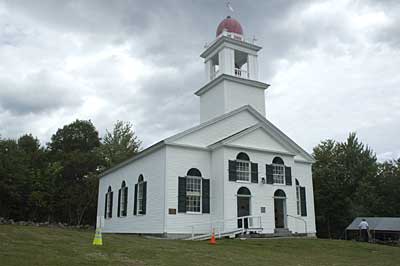
Bell Hill Meeting House is in Otisfield, four or five miles north of our house. We stumbled across it one day, just “let’s see where that road goes, there might be a ince view from the top of the hill” — and there is, but the building is entirely unexpected up here, far from any town center. In previous years we’ve seen newspaper announcements of an annual service there, but have never had a chance to go. I’ve wanted to see what it’s like inside. This year the paper said there would be an open house and tours from 1 to 3 last Sunday. It also announced a service — but the article about that didn’t have a time or date! We decided to try to get there promptly at 1. There were several cars parked when we got there — other times we’ve driven up there we were the only car — and people were walking to the building carrying three-ring binders that looked suspiciously as if they held choir music. The service was going to be that day, at 2:30, and the choir was rehearsing in between.
We explored the area a little in the hour and a half we had. First, we looked around the cemetery across the road. Most of the stones dated from the late 1800s.
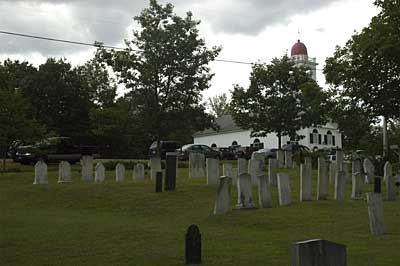
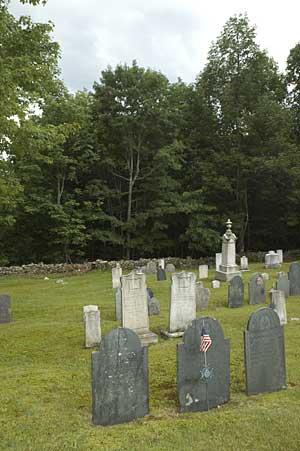
We walked a couple of hundred yards down the road, and then took a right on Peaco Hill Road, just because we had never driven down it. There was a gorgeous view from the side of it; maybe not as impressive as the view from Hacker’s Hill in Casco, but maybe. It’s certainly not like scenery in the West, but for New England this is very impressive.
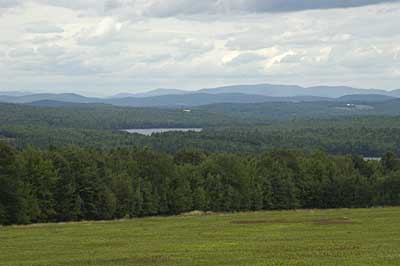
It turns out that in 1837, when the meetinghouse was built, Bell Hill was the center of Otisfield. There’s a brick one room schoolhouse, which was also open for the afternoon, next to the meeting house. Someone was going to reenact classes there later in the afternoon. We just poked in. I wasn’t all that interested in seeing a lesson, because my sisters and I had spent a real school day at a one room school in Vermont one fall when we were kids — it was probably in 1955 plus or minus two years. We did notice that the desks are different sizes, smaller towards the front so the younger kids can see the blackboard.
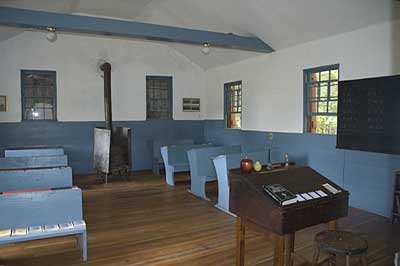
I took a couple of pictures inside the meeting house after the choir rehearsal and before things really started. First, looking toward the front. The flowers are all from a local garden.
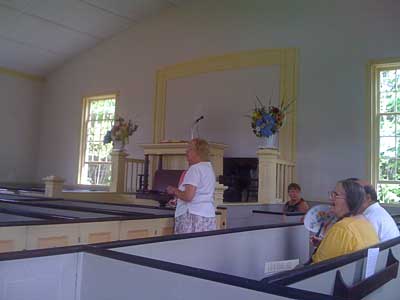
Then, looking toward the back. The pillars were added after lightning struck the tower and weakened several posts that held up the bell tower.
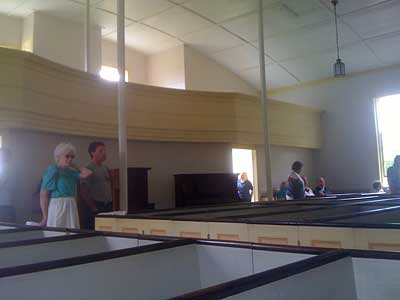
Besides some prayers and hymns (but no lessons from scripture) the service included a brief history of the church in the form of an imagined letter from a town resident in the 1840s to her sister, read by the woman who was going to re-enact the one room school class, and a talk about recent structural repairs to the building, by a local barnwright who does timber framing and other structural work. He said he had done long-term temporary repairs to the building, by which he meant they weren’t permanent repairs, which under historical preservation guidelines would have to be with materials similar to the original, but structural steel added in such a way that it could be removed, but that should last for a good 100 years.
